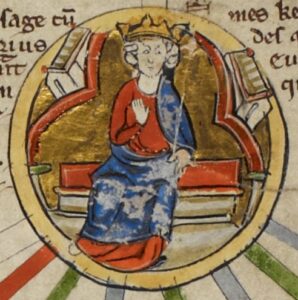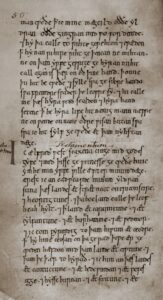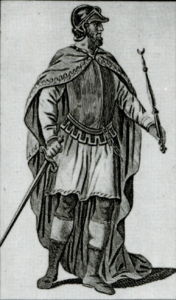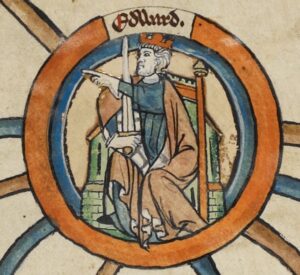Compared to his father, Alfred the Great, Edward the Elder was described by medieval chroniclers as “much inferior… in literature, but greatly excelled in extent of power.” And it was true. Alfred played a pivotal role in the history of England when he became the only Anglo-Saxon king to successfully fight off the Viking invasion. He then spent the rest of his reign fortifying his kingdom to ensure that Wessex would never face a similar threat again, but now it was time for Edward to take off the kid gloves and go on the offensive.
Edward, like his father, had a vision of a unified England (under his rule, of course), but he had a tough task ahead of him with enemies to the north and east, across the Channel, and even within his own kingdom. But he overcame obstacles and vanquished his foes as best he could, ensuring that the Kingdom of England became a reality, even though he was not the one to wear the crown.

Early Years
Edward’s early years are surprisingly obscure. Even though his dad was Alfred the Great, the self-proclaimed King of the Anglo-Saxons who had his own chronicler on stand-by, it seems that details such as the births of his children were just too minor to bother to write down, so we’re not really sure when or where Edward was born. An educated guess, however, would suggest circa mid-870s, somewhere in Wessex.
It could be worse, we suppose. When it came to Edward’s mother and Alfred’s wife, the aforementioned chronicler, Asser, did not even mention her by name. We do know, however, from other sources, that her name was Eahlswith, and that she was the daughter of a Mercian nobleman named Ethelred Mucel, not to be confused with Alfred’s older brother Ethelred I, who served as king before him, who, in turn, should not be confused with Ethelred the Unready, the more famous king who came about a century later.
Eahlswith and Alfred got married in 868 AD, back when he was still prince and heir to the Kingdom of Wessex. They had five children together who survived to adulthood. Æthelflaed was the oldest sibling, and she married a Mercian lord whose name was…you guessed it – Ethelred. Edward was the oldest son of Alfred, but he did not become known as Edward the Elder to distinguish himself from a younger brother, nor did he ever have a son by that name. In fact, he was never called Edward the Elder in his own lifetime. This moniker was applied retroactively to separate him from the next Edward who came to rule the kingdom a hundred years later, Edward the Martyr.
Succession was another murky topic back in the 9th century, one which had evolved over time. As the eldest son of King Alfred, Edward was in a prime position to inherit his kingdom, but it wasn’t exactly a done deal. Primogeniture, or the right of the firstborn to inherit, had not become the norm yet. Although Alfred had named Edward as his successor, a council known as the Witan still had a say in the matter, especially in circumstances where there was more than one strong claimant to the throne, and, as it happened, Edward faced some stiff competition.
Remember that Alfred’s older brother, Ethelred, was King of Wessex before him, and Alfred only rose to the throne after his brother’s death. But Ethelred also had two sons – Æthelhelm and Æthelwold. At the time of their father’s death, both were infants, which was why they were passed over in favor of Alfred, but that did not mean that they gave up their rights forever. As the sons of the King of Wessex, their claim was just as strong as Edward’s.
Æthelhelm did not prove to be a problem. The only trace of his existence was a mention of him and his brother contesting Alfred’s will. After that, he completely vanished from the historical record so, presumably, he died sometime before the matter of succession even came up. Æthelwold, on the other hand, had no intention of going out without a fight, so if Edward wanted to become the new King of Wessex and, maybe, one day unite all of England, he would have to go through him first.
A Challenger Appears

In 899 AD, Alfred the Great passed away and Edward was crowned the new king on Whitsunday. According to the chronicles of the time, Edward was elected by the nobles without any issues. However, the actions that followed suggested otherwise. Alfred had made his own wishes clear – in an earlier charter, he had Edward recorded as king alongside himself. It was obvious that he wanted Edward to succeed him on the throne, but it seems that not everyone was on board with that idea. Æthelwold had surprisingly strong support, made even more surprising by the fact that Alfred was supposed to be the savior of the Anglo-Saxons; the king who stopped the Vikings from taking over all of England. It had been over a decade since Alfred decisively defeated Guthrum at the Battle of Edington and pushed back the Viking invasion, so maybe people had short memories back then, or maybe Alfred did something to damage his popularity in the meantime. By name, we only know of an ealdorman named Wulfhere from Wiltshire, who had some of his land confiscated by Alfred as punishment for desertion. It’s not hard to imagine that there were other nobles who harbored grudges against Alfred. They would not dare go against him while he was still alive, but now that the king was dead, they were keen to ensure that his dynasty got snuffed out alongside him.
Æthelwold wasted no time in acting. As soon as word reached him that Alfred shuffled off his mortal coil, he gathered his army and rode to Dorset, where he captured the settlements of Christchurch and Wimborne. Christchurch was a fortified encampment called a burh. Alfred had built dozens of them all over the kingdom so his men could guard themselves against surprise Viking raids. It was nice to have, but it wasn’t crucial.
Wimborne was the true prize. Besides its strategic position, roughly straddling the border between the eastern and western halves of the kingdom, it also had great symbolic value for Æthelwold. For starters, his father, Ethelred I, was buried there, but he may have also wanted to take part in a royal Anglo-Saxon tradition known as the “farm of one night.” Every year, in late autumn, after the harvest was finished, a royal tribute was gathered at several important estates in the kingdom and the king rode around to collect them. Some speculate that Æthelwold wanted to be there in person when the tribute arrived and claim the tribute as the rightful recipient.
For his part, Edward knew that trouble was brewing and expected Æthelwold to make a move against him. He reacted swiftly once he heard that his rival had taken over Wimborne. Edward gathered his own army and headed to Dorset, camping in the old Iron Age fort of Badbury Rings. This, too, was a place of symbolic power, as the nearby town of Badbury was used for political assemblies, but it also blocked Æthelwold’s path should he get any funny ideas about traveling east and trying to capture Winchester, the capital of the Kingdom of Wessex.
To put it simply, Edward deftly outmaneuvered his rival, but Æthelwold was not down for the count just yet. He saw an all-out battle with Edward as a surefire loss, so instead, he crossed Mercia and retreated to Northumbria, the northernmost Anglo-Saxon kingdom, which was firmly controlled by the Danes. What kind of support Æthelwold expected to find there, we cannot say, but the Anglo-Saxon Chronicle claims that the Danes “received him as their king.” There are even coins from that era that mention a king named Alwaldus, and historians believe that that was probably Æthelwold. How he managed it, what he promised them, we’ll never know, but now Æthelwold had some Viking muscle as backup and was ready for Round 2.
In 901 AD, Æthelwold launched the second part of his rebellion. He sailed with a fleet from Northumbria to East Anglia, the other kingdom in the hands of the Danes, and, once again, he made them an offer they couldn’t refuse and gained their allegiance. He then traveled north into Mercia and secured even more support there. Back before Alfred the Great, Mercia was its own kingdom. It was actually the biggest and most powerful one at one point, but the Viking raids left it in a severely weakened state so that when Alfred and Guthrum reached a peace between the Danes and the Anglo-Saxons, the two divided Mercia and each one added half to their own domains. In Edward’s time, Mercia was governed by his older sister, the aforementioned Æthelflaed, and her husband Ethelred, although how much autonomy they really had is up for debate. Anyway, the point is that Mercia had no shortage of royal families that might have wanted to extinguish Alfred’s bloodline for a chance of reviving the old glory days.
It had become clear that Æthelwold was doing the rounds through England, trying to unite all those who opposed Edward under his banner. He did a pretty good job of it, too, so once his army was roaring to go, he ventured into Edward’s side of Mercia and let his Vikings do what they did best – loot & pillage. After that, Æthelwold crossed the Thames into Wessex itself, capturing the fortified burh of Cricklade.
While all of this was going on, Edward sent his army into East Anglia to respond in kind. This prompted an immediate reaction from Æthelwold who followed Edward’s troops, perhaps hoping to trap them and crush them between two armies. As you might expect, this was something that Edward was eager to avoid, so he sent word to retreat.
For reasons lost to history, his Kentish contingent did not withdraw from the action, despite Edward sending messengers to them on seven separate occasions. What followed next was the Battle of the Holme, where after prolonged delays and raids, the two sides finally “clashed shields, wielded swords, and shook greatly the spear in either hand.” That’s about all we know about this poorly-documented battle. We’re not even really sure where the Holme was, but we can say that the engagement proved disastrous for both sides. For Wessex, it was bad because the Kentish forces were almost entirely obliterated. The leader of the Kentish army, ealdorman Sigewulf, was killed in battle, as was almost every other Kentish lord. The Vikings, on the other hand, suffered much fewer losses, but among the dead was none other than Æthelwold himself.
With the leader of the revolt slain in battle, the rebellion lost all of its steam. Now, there was nobody left who could legitimately challenge Edward’s claim to the throne. The Danes from East Anglia and Northumbria kept fighting for a while, but their hearts were clearly not in it, anymore. Eventually, they struck peace and went back to minding their own kingdoms, while Edward was now free to rule over Wessex uncontested.
The Conquest

Following years of dealing with a dangerous thorn in his side, Edward decided that it was time for a much-deserved break so the next few years were pretty quiet, with no events of note being mentioned in the medieval chronicles. Or maybe he simply needed more time to prepare for his true ambition – the unification of England. Ever since his great-grandfather Ecbert conquered the Kingdoms of Essex, Sussex, and Kent, and placed them under the aegis of Wessex, Edward’s family wanted to bring all of England together under their rule. By thwarting the Viking invasion and building a strong kingdom, his father Alfred was in the best position to do it, but he died before he got his chance. However, he set up the table nicely for Edward to continue where he left off, and he intended to make full use of the opportunity.
In 909 AD Edward gathered an army of West Saxons and Mercians and marched into Northumbria. There, he embarked on a five-week-long campaign of murder and mayhem that saw his army pillage every Danish town, village, and hamlet that had the misfortune of getting in their way. This included, at one point, raiding the final resting place of Saint Oswald of Northumbria at Bardney Abbey, collecting his holy relics, and moving them to Mercia.
Unsurprisingly, the Danes didn’t just take this lying down. Instead, they also mustered an army and marched south into Mercia, looking to do a little plundering of their own. However, Edward knew this would happen and was ready for them. The two sides fought on August 5, 910 AD, at the Battle of Tettenhall, where the Anglo-Saxon forces delivered a crushing defeat to the Vikings. Again, no specifics, but the Danes suffered heavy losses that numbered in the “many thousands,” which included two kings, Eowils and Halfdan, two earls, and many other lords. Following this damn good wallopping, the northern Danes tucked tails and ran back to Northumbria and spent the rest of Edward’s reign licking their wounds, no longer a threat. This allowed the King of Wessex to turn his attention to his enemies to the east.
Unfortunately for Edward, the victory up north was soon followed by a setback. In 911 AD, he lost one of his strongest allies, his brother-in-law Ethelred, who had been the nominal ruler of the Anglo-Saxon side of Mercia. However, his widow, Edward’s sister Æthelflaed was ready and willing to pick up the slack. Edward assumed direct control of some major cities such as London and Oxford, but the rest of the territory was placed in Æthelflaed’s hands, who took the title of “Lady of the Mercians.” Taking a page out of their father’s book, the brother-and-sister combo spent the next five years shoring up their defenses by building new burhs and fortresses throughout their kingdoms.
This strategy paid off. It was not as flashy or thrilling as riding into battle with raised swords glinting in the sun, but it was effective and it took advantage of the fact that the Viking power was decentralized and disseminated among all the major cities under their control. The Danes from York weren’t on the same page as the Danes in Essex or Cambridge, and Edward understood that a display of overwhelming power would have been enough to persuade most of them to submit to him.
And he was right, for the most part. The Anglo-Saxon Chronicle tells us that many settlements both in East Anglia and Mercia showed submission to King Edward rather than fighting him. We can’t tell you what this “submission” really meant. Were they officially part of his kingdom? Were they vassals? Did they pay tribute or send him a Christmas card? It’s all pretty murky, but it is highly likely that some of the more powerful Viking leaders retained a significant degree of autonomy.
It’s not like the agreements were set in stone or anything. Edward knew that whenever Vikings got the itch, they would go out plundering, treaties be damned. In 917 AD, right after Easter, an army of Danes out of Northampton and Leicester broke the truce and sacked the town of Hookerton. Such raids were always going to happen, but thanks to Edward’s network of burhs, none of them got the chance to develop into a more serious threat. Then, a show of force was usually enough to get everyone to settle down, like in 919 when Edward marched with his army and conquered Bedford, prompting all the nearby settlements to reaffirm their allegiance to him.
Control & Influence

After a few years like this, Edward the Elder held a tenuous grip over most of England. He didn’t have the money, soldiers, or resources to outright capture and incorporate all of the territories under a single kingdom, but his “slowly, but surely” approach saw his sphere of influence get larger and larger. It seemed like all he needed was time.
Up in the north, Æthelflaed was doing her bit to help out the family legacy. It was said that, by 918 AD, all of the Danish settlements south of the Humber had offered their submission, although to whom exactly they submitted is another matter of contention. It’s pretty clear that Edward and Æthelflaed acted in tandem when it came to fortifying their kingdoms, but that could not prevent a little sibling rivalry from developing. The Mercian Register, for example, was careful to specify that the Danish armies submitted to Æthelflaed, with no kind of submission towards Edward indicated or implied. The Anglo-Saxon Chronicle, however, which was basically his side of the story, only mentioned Edward and not Æthelflaed.
It is possible that the big sis was no longer content sitting in her little brother’s shadow when she was doing half the work, but fate decided to put an end to their issues before any simmering resentments had a chance to boil over into an all-out sibling squabble. In 918 AD, Æthelflaed died and she was buried at Gloucester. She didn’t have any sons so she was succeeded by her daughter, Ælfwynn, but not for long. Just a few months after Æthelflaed’s death, Edward decided to take direct control of Mercia, while his niece “was deprived of all dominion over the Mercians, and carried into Wessex, three weeks before mid-winter.”
This was probably another sign that things had not been completely cool between brother and sister, or perhaps it was simply a precautionary step from Edward. After what had happened with his cousin, Æthelwold, he may have decided that it was safer not to let his close blood relatives roam free and unchecked, just in case one of them might try to stake a claim for the throne later on. This is all pure guesswork, by the way. Some scholars believe that Ælfwynn was eventually married off to a nobleman, while others think it is more likely that she joined the church. Ultimately, the fate of Ælfwynn remains a mystery.
Once the other Anglo-Saxon kingdoms were under Edward’s influence, to varying degrees, the King of Wessex turned his attention to Wales and Scotland. Wales didn’t prove too difficult. It was already under Edward’s auspices ever since he came to their rescue in 918 when a powerful Viking fleet sailed from Brittany led by two earls, Ohter and Rhoald. They plundered North Wales and took the Bishop of Archenfield hostage. However, King Edward paid his ransom and then raised an army from Hertford and Gloucester that defeated the invaders, killing Rhoald and sending the Vikings back to their shores. As thanks for his assistance, in 920 AD, the kings of North Wales, Howel the Good and Cledauc, both recognized Edward as their overlord.
More interesting and mysterious was Edward’s status in Scotland. We’re going by the Chronicle again, which wrote that “the king of the Scots and all the people of the Scots, and Ragnald, and the sons of Eadwulf and all who live in Northumbria, both English and Danish, Norsemen and other, and also the king of the Strathclyde Welsh and all the Strathclyde Welsh chose him as father and lord.”
How and why this arrangement came about is up for debate. No contemporary sources present any valid reasons why Ragnald, an independent and powerful king who ruled over parts of Scotland, Northumbria, and the Isle of Mann, would kowtow before Edward, at least not without a little scrap first, and modern historians think it’s more likely that their agreement was more of a peace treaty between equal nations instead of one submitting to the other. But, as we said, the Anglo-Saxon Chronicle was Edward’s version of events. We’ve all lied on our resumes on occasion, and being chosen as “father and lord” sounds a lot more impressive than simply negotiating a peace treaty.
The last few years of Edward’s reign were a bit dull but practical. Once more, he mirrored his father’s approach, who spend his waning years building fortifications and trying to improve his kingdom’s literacy. For his part, Edward traveled from town to town, helping to rebuild and improve them. Some of the locations mentioned by name include Nottingham, Stamford, Towcester, Thelwall, and Maldon.
Again, just like Alfred the Great, Edward might have felt that his time was coming to an end even though he still had unfinished work to do. But he would not give up, either, and instead, he strengthened his kingdom as much as possible so that his own son could take up the family quest.
And he was right. In 924 AD, Edward the Elder died and was buried in Winchester. He passed the baton to his son Æthelstan who succeeded him and brought his father and grandfather’s ambition to fruition by becoming the first King of England. But that is a story that we will cover another time.



